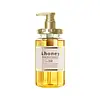What's inside
What's inside
 Key Ingredients
Key Ingredients

No key ingredients
 Benefits
Benefits

 Concerns
Concerns

No concerns
 Ingredients Side-by-side
Ingredients Side-by-side

Water
Skin ConditioningLauramidopropyl Betaine
CleansingSodium C14-16 Olefin Sulfonate
CleansingSodium Lauroyl Taurate
CleansingGlycerin
HumectantCocamide DEA
EmulsifyingTea-Lauroyl Methylaminopropionate
CleansingTea-Cocoyl Glutamate
CleansingParfum
MaskingPolyquaternium-10
Sodium Benzoate
MaskingMyristyl Betaine
CleansingPhenoxyethanol
PreservativeCitric Acid
BufferingDisodium EDTA
Polyquaternium-47
Skin ConditioningMenthol
MaskingCaramel
Cosmetic ColorantHoney
HumectantArginine
MaskingPanthenol
Skin ConditioningArgania Spinosa Kernel Oil
EmollientShea Butter Glycereth-8 Esters
CleansingButylene Glycol
HumectantGluconobacter/Honey Ferment Filtrate
Skin ConditioningPPG-7
Skin ConditioningAcacia Senegal Gum
MaskingHoney Extract
HumectantCoco-Glucoside
CleansingKeratin
Skin ConditioningHydrolyzed Honey Protein
Skin ConditioningRoyal Jelly Extract
Skin ConditioningPaeonia Officinalis Flower Extract
TonicPropolis Extract
Skin ConditioningHydrolyzed Silk
HumectantHydroxypropyltrimonium Hyaluronate
Methylchloroisothiazolinone
PreservativeMethylisothiazolinone
PreservativePotassium Sorbate
PreservativeMagnesium Nitrate
Magnesium Chloride
Water, Lauramidopropyl Betaine, Sodium C14-16 Olefin Sulfonate, Sodium Lauroyl Taurate, Glycerin, Cocamide DEA, Tea-Lauroyl Methylaminopropionate, Tea-Cocoyl Glutamate, Parfum, Polyquaternium-10, Sodium Benzoate, Myristyl Betaine, Phenoxyethanol, Citric Acid, Disodium EDTA, Polyquaternium-47, Menthol, Caramel, Honey, Arginine, Panthenol, Argania Spinosa Kernel Oil, Shea Butter Glycereth-8 Esters, Butylene Glycol, Gluconobacter/Honey Ferment Filtrate, PPG-7, Acacia Senegal Gum, Honey Extract, Coco-Glucoside, Keratin, Hydrolyzed Honey Protein, Royal Jelly Extract, Paeonia Officinalis Flower Extract, Propolis Extract, Hydrolyzed Silk, Hydroxypropyltrimonium Hyaluronate, Methylchloroisothiazolinone, Methylisothiazolinone, Potassium Sorbate, Magnesium Nitrate, Magnesium Chloride
 Reviews
Reviews

Ingredients Explained
These ingredients are found in both products.
Ingredients higher up in an ingredient list are typically present in a larger amount.
Citric Acid is an alpha hydroxy acid (AHA) naturally found in citrus fruits like oranges, lemons, and limes.
Like other AHAs, citric acid can exfoliate skin by breaking down the bonds that hold dead skin cells together. This helps reveal smoother and brighter skin underneath.
However, this exfoliating effect only happens at high concentrations (20%) which can be hard to find in cosmetic products.
Due to this, citric acid is usually included in small amounts as a pH adjuster. This helps keep products slightly more acidic and compatible with skin's natural pH.
In skincare formulas, citric acid can:
While it can provide some skin benefits, research shows lactic acid and glycolic acid are generally more effective and less irritating exfoliants.
Most citric acid used in skincare today is made by fermenting sugars (usually from molasses). This synthetic version is identical to the natural citrus form but easier to stabilize and use in formulations.
Read more about some other popular AHA's here:
Learn more about Citric AcidCoco-Glucoside is a surfactant, or a cleansing ingredient. It is made from glucose and coconut oil.
Surfactants help gather dirt, oil, and other pollutants from your skin to be rinsed away.
This ingredient is considered gentle and non-comedogenic. However, it may still be irritating for some.
Learn more about Coco-GlucosideGlycerin is already naturally found in your skin. It helps moisturize and protect your skin.
A study from 2016 found glycerin to be more effective as a humectant than AHAs and hyaluronic acid.
As a humectant, it helps the skin stay hydrated by pulling moisture to your skin. The low molecular weight of glycerin allows it to pull moisture into the deeper layers of your skin.
Hydrated skin improves your skin barrier; Your skin barrier helps protect against irritants and bacteria.
Glycerin has also been found to have antimicrobial and antiviral properties. Due to these properties, glycerin is often used in wound and burn treatments.
In cosmetics, glycerin is usually derived from plants such as soybean or palm. However, it can also be sourced from animals, such as tallow or animal fat.
This ingredient is organic, colorless, odorless, and non-toxic.
Glycerin is the name for this ingredient in American English. British English uses Glycerol/Glycerine.
Learn more about GlycerinWater. It's the most common cosmetic ingredient of all. You'll usually see it at the top of ingredient lists, meaning that it makes up the largest part of the product.
So why is it so popular? Water most often acts as a solvent - this means that it helps dissolve other ingredients into the formulation.
You'll also recognize water as that liquid we all need to stay alive. If you see this, drink a glass of water. Stay hydrated!
Learn more about Water